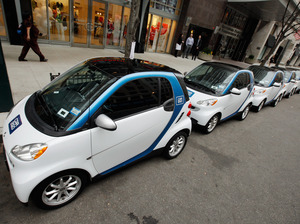 For someone who has lamented the negative impacts that cars have had on cities, a fundamental change appears in the offing, with implications as large as those when cars first appeared. This change is made up of different elements. One element is the changing relationship people have with cars, from being a reflection of who we are, to merely being a tool. This change was discussed the other day on NPR, which had a story, What Drives Us? Car Sharing Reflects Cultural Shift, that talked about the rise of car sharing, such as Zipcar as well as peer to peer sharing. Another element is the move for autonomous cars which drive themselves, such as the cars being developed by Google. These cars are now legal in California and the State of California passed a law last year that requires the California Department of Motor Vehicles develop regulations for autonomous cars by 2015. The last element is rise of such services as Uber, an app for iPhone and Android, that lets you order a car with a private driver from your phone.
For someone who has lamented the negative impacts that cars have had on cities, a fundamental change appears in the offing, with implications as large as those when cars first appeared. This change is made up of different elements. One element is the changing relationship people have with cars, from being a reflection of who we are, to merely being a tool. This change was discussed the other day on NPR, which had a story, What Drives Us? Car Sharing Reflects Cultural Shift, that talked about the rise of car sharing, such as Zipcar as well as peer to peer sharing. Another element is the move for autonomous cars which drive themselves, such as the cars being developed by Google. These cars are now legal in California and the State of California passed a law last year that requires the California Department of Motor Vehicles develop regulations for autonomous cars by 2015. The last element is rise of such services as Uber, an app for iPhone and Android, that lets you order a car with a private driver from your phone.
Take these elements together and world opens up where you no longer own a car, but pay into a subscription service that you access from you phone and where an autonomous car comes to your door several minutes after you order it. You go to work, shopping, or on the town in a car that drives itself. For most trips they will likely be small electric cars, but when you order, you will have choice, depending on the number of people and where you are going. If you don’t own a car, you no longer need to house the car, so houses will go back to being a house, rather than an appendage to a garage. The current debates about parking and the amount of off street parking will become irrelevant. The cars won’t park near your house, business or at shops. When you get out the cars go to transport the next person. They will eventually be parked in very efficient parking structures where they will be cleaned and prepped for the next days service.
The results for cities is that parking lots, essentially empty spaces between buildings, will become available for other uses. Public spaces will still have cars, but the balance between them and pedestrian uses will start going back toward pedestrians. It will offer interesting design challenges of how to transform the typical shopping mall. What do you do with the parking? The size of streets will be impacted since traffic will be more efficiently regulated. There still be high traffic times but the overall number of cars will be reduced. This means the need for on-street parking also starts to disappear, leaving for more space for pedestrians and bicycles and other activities that traditionally were parts of streets, but where shoved off due to cars.
My brother, who is a cab driver in San Francisco, has been aware of this transformation for some time and talks about how this will change many aspects of life we take for granted. What happens to insurance companies when the demand for car insurance drys up? What about police departments who no longer give out as many traffic fines and parking tickets? Will traditional cab companies become part of this transformation or disappear? What happens to the mass transit systems? How will road maintenance be paid for? All good questions and it will be interesting to see how it plays out. What he is convinced of, and I agree with, is that this change is coming, and faster than most people realize.

Comments
One response to “The future of cars and cities”
The Economist recently had an article on driverless cars as well so the topic is current.
http://www.economist.com/news/leaders/21576384-cars-have-already-changed-way-we-live-they-are-likely-do-so-again-clean-safe-and-it